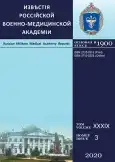The case of the multistage treatment of acute pancreatitis using a variety of minimally invasive techniques
- 作者: Ivanusa S.Y.1, Lazutkin M.1, Shershen D.1, Chebotar A.1
-
隶属关系:
- S. M. Kirov Military Medical Academy
- 期: 卷 39, 编号 3 (2020)
- 页面: 40-49
- 栏目: Case report
- URL: https://journal-vniispk.ru/RMMArep/article/view/64959
- DOI: https://doi.org/10.17816/rmmar64959
- ID: 64959
如何引用文章
全文:
详细
Treatment of acute pancreatitis and infectious complications is a complex multidisciplinary task. The use of traditional surgical procedures for the rehabilitation of foci of pancreatogenic infection often aggravates the course of the disease, leads to the development of postoperative complications, does not improve the results of treatment. On the contrary, the use of minimally invasive techniques avoids additional surgical injury. The case of stage treatment of acute pancreatitis and its purulent-septic complications with the use of minimally invasive technologies is presented to the readers.
作者简介
Sergey Ivanusa
S. M. Kirov Military Medical Academy
编辑信件的主要联系方式.
Email: koptata@mail.ru
SPIN 代码: 8752-1600
M. D., D. Sc. (Medicine), Professor, the Head of the General Surgery Department
俄罗斯联邦, bld. 6, Akademika Lebedeva str., Saint Petersburg, 194044Maksim Lazutkin
S. M. Kirov Military Medical Academy
Email: koptata@mail.ru
SPIN 代码: 9364-8068
M. D., D. Sc. (Medicine), Deputy Head of the General Surgery Department
俄罗斯联邦, bld. 6, Akademika Lebedeva str., Saint Petersburg, 194044Dmitriy Shershen
S. M. Kirov Military Medical Academy
Email: koptata@mail.ru
SPIN 代码: 2531-5640
M. D., Ph. D. (Medicine), Senior Lecturer of the General Surgery Department
俄罗斯联邦, bld. 6, Akademika Lebedeva str., Saint Petersburg, 194044Anton Chebotar
S. M. Kirov Military Medical Academy
Email: koptata@mail.ru
SPIN 代码: 5923-9859
Major of Medical Service, teacher of the 2nd faculty
俄罗斯联邦, bld. 6, Akademika Lebedeva str., Saint Petersburg, 194044参考
补充文件







